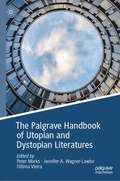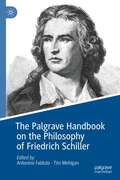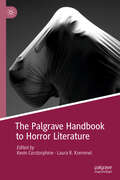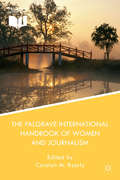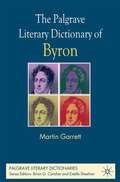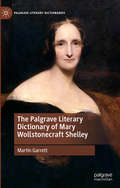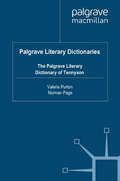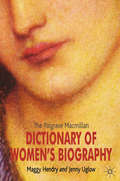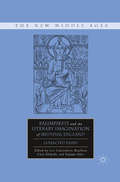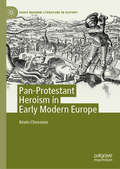- Table View
- List View
The Palgrave Handbook of the Southern Gothic
by Charles L. Crow Susan Castillo StreetThis book examines ‘Southern Gothic’ - a term that describes some of the finest works of the American Imagination. But what do ‘Southern’ and ‘Gothic’ mean, and how are they related? Traditionally seen as drawing on the tragedy of slavery and loss, ‘Southern Gothic’ is now a richer, more complex subject. Thirty-five distinguished scholars explore the Southern Gothic, under the categories of Poe and his Legacy; Space and Place; Race; Gender and Sexuality; and Monsters and Voodoo. The essays examine slavery and the laws that supported it, and stories of slaves who rebelled and those who escaped. Also present are the often-neglected issues of the Native American presence in the South, socioeconomic class, the distinctions among the several regions of the South, same-sex relationships, and norms of gendered behaviour. This handbook covers not only iconic figures of Southern literature but also other less well-known writers, and examines gothic imagery in film and in contemporary television programmes such as True Blood and True Detective.
The Palgrave Handbook of Transnational Women’s Writing in the Long Nineteenth Century
by Claire Emilie Martin Clorinda DonatoThis handbook explores the rich and as yet understudied field of women’s writing during the nation-building years that characterized the global politics of the long nineteenth century. In the wake of the American and French Revolutions, the waning of the Spanish Empire, subsequent Latin American uprisings, and the Italian Risorgimento, nineteenth-century women writers cracked wide open the myths of gender, race, and class that had sustained the ancien régime. This volume shows that the transnational networks of women writing about politics, sexuality, economics, and the forging of the modern nation were much broader and more inclusive at a global level than has previously been understood. The handbook uniquely foregrounds French, Italian, Latin American, and Spanish women writers, focusing on the transnational nature of their relationships and cultural production within a growing body of research that casts an ever-wider net in the effort to document women’s voices.
The Palgrave Handbook of Twentieth and Twenty-First Century Literature and Science (Palgrave Handbooks of Literature and Science)
by Rebecca Walsh Priscilla Wald Gerry Canavan Monique Allewaert Nicholas Gaskill Patrick Jagoda Neel Ahuja Rebecca Evans Aarthi Vadde Britt Rusert Erin Gentry Lamb Jennifer Rhee Erica Fretwell Lindsey Andrews Nihad M. Farooq Matthew A. TaylorThis handbook illustrates the evolution of literature and science, in collaboration and contestation, across the twentieth and twenty-first centuries. The essays it gathers question the charged rhetoric that pits science against the humanities while also demonstrating the ways in which the convergence of literary and scientific approaches strengthens cultural analyses of colonialism, race, sex, labor, state formation, and environmental destruction. The broad scope of this collection explores the shifting relations between literature and science that have shaped our own cultural moment, sometimes in ways that create a problematic hierarchy of knowledge and other times in ways that encourage fruitful interdisciplinary investigations, innovative modes of knowledge production, and politically charged calls for social justice. Across units focused on epistemologies, techniques and methods, ethics and politics, and forms and genres, the chapters address problems ranging across epidemiology and global health, genomics and biotechnology, environmental and energy sciences, behaviorism and psychology, physics, and computational and surveillance technologies.Chapter 19 is available open access under a Creative Commons Attribution 4.0 International License via link.springer.com.
The Palgrave Handbook of Utopian and Dystopian Literatures
by Jennifer A. Wagner-Lawlor Peter Marks Fátima VieiraThe Palgrave Handbook of Utopian and Dystopian Literatures celebrates a literary genre already over 500 years old. Specially commissioned essays from established and emerging international scholars reflect the vibrancy of utopian vision, and its resiliency as idea, genre, and critical mode. Covering politics, environment, geography, body and mind, and social organization, the volume surveys current research and maps new areas of study. The chapters include investigations of anarchism, biopolitics, and postcolonialism and study film, art, and literature. Each essay considers central questions and key primary works, evaluates the most recent research, and outlines contemporary debates. Literatures of Africa, Australia, China, Latin America, and the Middle East are discussed in this global, cross-disciplinary, and comprehensive volume.
The Palgrave Handbook on Rethinking Colonial Commemorations
by Bronwyn Carlson Terri FarrellyThe Palgrave Handbook on Rethinking Colonial Commemorations explores global efforts, particularly from Indigenous and Bla(c)k communities, to dismantle colonial commemorations, monuments, and memorials. Across the world, many Indigenous and Bla(c)k communities have taken action to remove, rectify and/or re-imagine colonial commemorations. These efforts have had the support of some non-Indigenous and white community members, but very often they have faced fierce opposition. In spite of this, many have succeeded, and this work aims to acknowledge and honour these efforts. As a current and much-debated issue, this book will present fresh findings and analyses of recent and historical events, including #RhodesMustFall, Anzac Day protests, and the transferral of confederate monuments to museums. Comprising of chapters written by Indigenous, Bla(c)k and non-Indigenous authors, from a wide variety of locations, backgrounds and purposes, this topical volume is a timely and important contribution to the fields of memory studies, Indigenous Studies, and cultural heritage.
The Palgrave Handbook on the Philosophy of Friedrich Schiller
by Antonino Falduto Tim MehiganFriedrich Schiller is justly celebrated for his dramas and poetry. Yet, above all, he was a polymath, whose writings enriched a range of fields including history and philosophy. Until now, no comprehensive accounting of this philosophy has been undertaken. The Palgrave Handbook on the Philosophy of Friedrich Schiller makes good this desideratum, treating Schiller's poetry, prose, and dramatic work alongside his philosophical writings and reviewing his thought not only in connection with those who influenced him, such as Kant, Reinhold, and Fichte, but also those he anticipated, such as Hegel, Marx, and the Neo-Kantians. Topics treated in this volume include Schiller's philosophical background, his theoretical writings, Schiller's philosophical writing in light of his entire oeuvre, and Schiller's philosophical legacy. The Handbook also includes an overview of the main topics Schiller addressed in his philosophical writings including philosophical anthropology, aesthetics, moral philosophy, politics and political theory, the philosophy of history, and the philosophy of education. Bringing together the latest research on Schiller and his thought by leading scholars in the field, the Handbook draws attention to Schiller's undiminished importance for philosophical debates today.
The Palgrave Handbook to Horror Literature
by Kevin Corstorphine Laura R. KremmelThis handbook examines the use of horror in storytelling, from oral traditions through folklore and fairy tales to contemporary horror fiction. Divided into sections that explore the origins and evolution of horror fiction, the recurrent themes that can be seen in horror, and ways of understanding horror through literary and cultural theory, the text analyses why horror is so compelling, and how we should interpret its presence in literature. Chapters explore historical horror aspects including ancient mythology, medieval writing, drama, chapbooks, the Gothic novel, and literary Modernism and trace themes such as vampires, children and animals in horror, deep dark forests, labyrinths, disability, and imperialism. Considering horror via postmodern theory, evolutionary psychology, postcolonial theory, and New Materialism, this handbook investigates issues of gender and sexuality, race, censorship and morality, environmental studies, and literary versus popular fiction.
The Palgrave International Handbook of Women and Journalism
by Carolyn M. ByerlyNow in paperback for the first time, the Handbook is an academic adaptation of information contained in the Global Report on the Status of Women in News Media, a study commissioned by the International Women's Media Foundation. The book's editor was the principal investigator of the original study. This text draws together the most robust data from that original study, presenting it in 29 chapters on individual nations and three additional theoretical chapters. The book is the most expansive effort to date to consider women's standing in the journalism profession across the world. Contents organize nations in relation to their progress within newsrooms, with those most advanced in gender equality representing diversity in terms of region and national development. Contributing authors are, in most cases, the original researchers for their respective nations in the Global Report study.
The Palgrave Literary Dictionary of Byron (Palgrave Literary Dictionaries)
by M. GarrettA comprehensive guide to the poems, prose, biography, ideas and contexts of Byron, entries range from detailed coverage of the major poems to items on Byron's songs, conversation, interest in boxing, swimming and vampires, and sexual liaisons; also the 'Byronic Hero', Byron in fiction and drama, and his pervasive influence on subsequent literature.
The Palgrave Literary Dictionary of Chaucer (Palgrave Literary Dictionaries)
by M. AndrewThis study aims to provide readers with a convenient source of reliable, scholarly, and accessible information on Chaucer's work, life, and times. Topics include Chaucer's works, major fictional characters, social, and political contexts, writers who influenced Chaucer or influenced by him, people and places of significance in Chaucer's life.
The Palgrave Literary Dictionary of Mary Wollstonecraft Shelley (Palgrave Literary Dictionaries)
by Martin GarrettThis volume considers the work and life of Mary Wollstonecraft Shelley (1797-1851). It looks not only at Frankenstein and its composition, sources, themes and reception but at the wide range of other work by Shelley including such novels as The Last Man and Mathilda and her tales, reviews, travel writing and the (until recently neglected) Literary Lives of Italian, Spanish, Portuguese and French writers. There are detailed entries on her personal and/or literary relationship with her parents Mary Wollstonecraft and William Godwin, her husband Percy Bysshe Shelley, Byron, Coleridge and Claire Clairmont; on her religion, feminism, politics, relation to Romanticism, portraits and representation in drama, film and television; and on the influence of her work on such writers as Poe, Elizabeth Gaskell, the Brontës, Dickens and H.G. Wells.
The Palgrave Literary Dictionary of Samuel Taylor Coleridge (Palgrave Literary Dictionaries)
by Martin GarrettThis volume explores ‘the labyrinth of what we call Coleridge’ (Virginia Woolf): his poems and prose, their sources, interpretation and reception; his life, troubled marriage and fatherhood, conversation, changing intellectual contexts and legacy. Major entries cover such canonical works as The Rime of the Ancient Mariner, Christabel, ‘Kubla Khan’, the ‘conversation poems’ and Biographia Literaria. But a fuller understanding of Coleridge must embrace many lesser-known poems – lyrics, satire, comical squibs. The prose – critical, philosophical, political, religious – ranges from his early radical writings to the more conservative On the Constitution of the Church and State, his influential Shakespeare lectures, and the vast resource of the notebooks. Coleridge read widely throughout his life and engaged extensively with the work of, among many others, Milton, Fielding, Berkeley, Priestley, Kant, Schelling. One of his most important relationships was with William Wordsworth. Another was with Sara Hutchinson. Entries trace Coleridge’s changing reputation, from brilliant young activist to the ‘Sage of Highgate’ to the later apostle of the theories of the imagination and of Practical Criticism. Other topics covered include opium, plagiarism, the French Revolution, Pantisocracy, Unitarianism, and the Salutation and Cat tavern.
The Palgrave Literary Dictionary of Shelley (Palgrave Literary Dictionaries)
by M. GarrettThis comprehensive guide to the poems, prose, biography, ideas and contexts of Percy Bysshe Shelley features entries on all the major poems and prose works (including inspiration, composition and publication), Shelley's politics, relationships and travels, his representation in novels, drama, film and portraits, and his critical reception.
The Palgrave Literary Dictionary of Tennyson (Palgrave Literary Dictionaries)
by V. Purton N. PageTennyson is the most important English poet of the Victorian age. He knew its key figures and was deeply involved in its science, religion, philosophy and politics. The Palgrave Literary Dictionary for the first time gives easily accessible information, under more than 400 headings, on his poetry, his circle, the period and its contexts.
The Palgrave Macmillan Dictionary of Women's Biography
by M. Hendry J UglowThe Palgrave Macmillan Dictionary of Women's Biography contains details of the lives of over 2100 women from all periods, cultures and walks of life - from queens to TV chefs, engineers to stand up comics, pilots to poisoners. With subsections for further reading, comprehensive subject index and a bibliographical survey, this dictionary of women's biography is an invaluable reference source.
Palimpsests and the Literary Imagination of Medieval England: Collected Essays (The New Middle Ages)
by Tatjana Silec R. Chai-Elsholz L. CarruthersWitnesses to the disappearance of a text, palimpsest manuscripts bear the marks of their own genesis, with their original inscription rubbed out and written over on the same parchment. This collection explores analogies of erasure and rewriting observed in editorial and literary practices underlying the production of texts from medieval England.
Palimpsests in Ethnic and Postcolonial Literature and Culture: Surfacing Histories
by Yiorgos D. Kalogeras Johanna C. Kardux Monika Mueller Jopi NymanThis volume explores ways in which the literary trope of the palimpsest can be applied to ethnic and postcolonial literary and cultural studies. Based on contemporary theories of the palimpsest, the innovative chapters reveal hidden histories and uncover relationships across disciplines and seemingly unconnected texts. The contributors focus on diverse forms of the palimpsest: the incarceration of Native Americans in military forts and their response to the elimination of their cultures; mnemonic novels that rework the politics and poetics of the Black Atlantic; the urban palimpsests of Rio de Janeiro, Marseille, Johannesburg, and Los Angeles that reveal layers of humanity with disparities in origin, class, religion, and chronology; and the palimpsestic configurations of mythologies and religions that resist strict cultural distinctions and argue against cultural relativism.
Pamela Hansford Johnson: A Writing Life
by Deirdre DavidDeirdre David traces the successful writing life of Pamela Hansford Johnson (1912-1981) from the time of her childhood growing up in a theatrical household in South London to her death as the widow of the novelist and popular intellectual C. P. Snow. Forced to leave school at sixteen, she trained as a shorthand typist, worked for four years in the mid 1930 for a West End Bank, and conducted a tumultuous romance with the then 19-year old poet Dylan Thomas. Thomas having persuaded her she would become a better novelist than a poet she published a scandalous first novel in 1935 and went on to publish close to thirty more in her career. A passionate defender of the narrative traditions of the British novel, she contributed many essays and reviews on contemporary fiction to periodicals and newspapers; in her own fiction, in the nineteenth-century traditions of Jane Austen, George Eliot, and Charles Dickens, she focused on the domestic everyday, the moral questions facing a rapidly-changing society, and the challenges and pleasures of urban life. She was very much a novelist of the city, particularly London. She also gained praise and criticism for her writings about violence and pornography, especially in her well-known analysis of the notorious Moors murder trial. With C. P. Snow, she travelled many times to the United States and the Soviet Union and at the time of her death in 1981, she was still at work on her last novel. Hers was a rich, courageous, and politically committed writing life, and this biography restores Johnson's work to the critical distinction it received when it was published.
Pamela Hansford Johnson: A Writing Life
by Deirdre DavidDeirdre David traces the successful writing life of Pamela Hansford Johnson (1912-1981) from the time of her childhood growing up in a theatrical household in South London to her death as the widow of the novelist and popular intellectual C. P. Snow. Forced to leave school at sixteen, she trained as a shorthand typist, worked for four years in the mid 1930 for a West End Bank, and conducted a tumultuous romance with the then 19-year old poet Dylan Thomas. Thomas having persuaded her she would become a better novelist than a poet she published a scandalous first novel in 1935 and went on to publish close to thirty more in her career. A passionate defender of the narrative traditions of the British novel, she contributed many essays and reviews on contemporary fiction to periodicals and newspapers; in her own fiction, in the nineteenth-century traditions of Jane Austen, George Eliot, and Charles Dickens, she focused on the domestic everyday, the moral questions facing a rapidly-changing society, and the challenges and pleasures of urban life. She was very much a novelist of the city, particularly London. She also gained praise and criticism for her writings about violence and pornography, especially in her well-known analysis of the notorious Moors murder trial. With C. P. Snow, she travelled many times to the United States and the Soviet Union and at the time of her death in 1981, she was still at work on her last novel. Hers was a rich, courageous, and politically committed writing life, and this biography restores Johnson's work to the critical distinction it received when it was published.
Pamuk's Istanbul: The Self and the City
by Pallavi NarayanThis book reconstructs Istanbul through the prism of Orhan Pamuk’s fiction. It navigates the multiple selves and layers of Istanbul to present how the city has shaped the writings of Pamuk and has, in turn, been shaped by it. Through everyday objects and architecture, it shows how Pamuk transforms the city into a living museum where different objects converse along with characters to present a rich tapestry across space and time. Further, the monograph explores the formation of communal and literary identity within and around nation-building narratives informed by capitalism and modernization. The book also examines how Pamuk uses the postmodern city to move beyond its postmodern confines, and utilizes the theories and universes of Bakhtin, Benjamin, and Foucault to open up his fiction and radically challenge the idea of the novel. The volume will be of great interest to scholars and researchers of literature, literary theory, museum studies, architecture, and cultural studies, and especially appeal to readers of Orhan Pamuk.
Pamuk's Istanbul: The Self and the City
by Pallavi NarayanThis book reconstructs Istanbul through the prism of Orhan Pamuk’s fiction. It navigates the multiple selves and layers of Istanbul to present how the city has shaped the writings of Pamuk and has, in turn, been shaped by it. Through everyday objects and architecture, it shows how Pamuk transforms the city into a living museum where different objects converse along with characters to present a rich tapestry across space and time. Further, the monograph explores the formation of communal and literary identity within and around nation-building narratives informed by capitalism and modernization. The book also examines how Pamuk uses the postmodern city to move beyond its postmodern confines, and utilizes the theories and universes of Bakhtin, Benjamin, and Foucault to open up his fiction and radically challenge the idea of the novel. The volume will be of great interest to scholars and researchers of literature, literary theory, museum studies, architecture, and cultural studies, and especially appeal to readers of Orhan Pamuk.
Pan (Oxford World's Classics)
by Knut Hamsun'When the snow water had broken crevices open in the mountain a shot or even just a sharp cry was enough to tear loose a huge slab and send it toppling.' Lieutenant Thomas Glahn spends a summer in northern Norway, where the midnight sun triggers a short but intense release of energies. Living out of a rudimentary hut on the edge of the forest, he pursues a solitary existence, hunting, fishing, and engaging intermittently with the inhabitants of the nearby coastal village. Among these is Edvarda, daughter of the wealthy local trader Herr Mack. Their mutual attraction rapidly develops into an erotic fascination shot through with suspicions and jealousies; a series of fraught encounters culminates in violent actions with unforeseen consequences. First published in 1894, Pan was an immediate success and remains a classic of Norwegian literature. It embodies many of the distinctive features of Hamsun's early works, in particular a rejection of psychological stereotypes and a style infused by what Hamsun called a 'poetry of the nerves'. Terence Cave's new translation restores the power and virtuosity of Hamsun's original and includes an illuminating introduction and explanatory notes. ABOUT THE SERIES: For over 100 years Oxford World's Classics has made available the widest range of literature from around the globe. Each affordable volume reflects Oxford's commitment to scholarship, providing the most accurate text plus a wealth of other valuable features, including expert introductions by leading authorities, helpful notes to clarify the text, up-to-date bibliographies for further study, and much more.
Pan (Oxford World's Classics)
by Knut Hamsun'When the snow water had broken crevices open in the mountain a shot or even just a sharp cry was enough to tear loose a huge slab and send it toppling.' Lieutenant Thomas Glahn spends a summer in northern Norway, where the midnight sun triggers a short but intense release of energies. Living out of a rudimentary hut on the edge of the forest, he pursues a solitary existence, hunting, fishing, and engaging intermittently with the inhabitants of the nearby coastal village. Among these is Edvarda, daughter of the wealthy local trader Herr Mack. Their mutual attraction rapidly develops into an erotic fascination shot through with suspicions and jealousies; a series of fraught encounters culminates in violent actions with unforeseen consequences. First published in 1894, Pan was an immediate success and remains a classic of Norwegian literature. It embodies many of the distinctive features of Hamsun's early works, in particular a rejection of psychological stereotypes and a style infused by what Hamsun called a 'poetry of the nerves'. Terence Cave's new translation restores the power and virtuosity of Hamsun's original and includes an illuminating introduction and explanatory notes. ABOUT THE SERIES: For over 100 years Oxford World's Classics has made available the widest range of literature from around the globe. Each affordable volume reflects Oxford's commitment to scholarship, providing the most accurate text plus a wealth of other valuable features, including expert introductions by leading authorities, helpful notes to clarify the text, up-to-date bibliographies for further study, and much more.
Pan-Protestant Heroism in Early Modern Europe (Early Modern Literature in History)
by Kevin ChovanecThis book offers the first full study of the challenges posed to an emerging English nationalism that stemmed from the powerful appeal exerted by the leaders of the international Protestant cause. By considering a range of texts, including poetry, plays, pamphlets, and religious writing, the study reads this heroic tradition as a 'connected literary history,' a project shared by Protestants throughout Northern Europe, which opened up both collaboration among writers from these different regions and new possibilities for communal identification. The work’s central claim is that a pan-Protestant literary field existed in the period, which was multilingual, transnational, and ideologically charged. Celebrated leaders such as William of Orange posed a series of questions, especially for English Protestants, over the relationship between English and Protestant identity. In formulating their role as co-religionists, writers often undercut notions of alterity, rendering early modern conceptions of foreignness especially fluid and erasing national borders.
The Panchatantra: Translated from the Sanskrit (Routledge Revivals)
by Franklin EdgertonFirst Published in 1965, The Panchatantra is a reprint of Franklin Edgerton’s translation, first published in volume two of Panchatantra Reconstructed (1924), with some minor alterations. Probably no other work of Hindu literature has played so important a part in the literature of the world as the Sanskrit story collection called the Panchatantra. The title means ‘the five books’, and most of the older versions and translations keep this division, although the last two books are much shorter than the first three. All the ‘books’ contain at least one story, and usually more, which are ‘emboxed’ in the main story, called the ‘frame-story’. The original Sanskrit text is composed in a mixture of prose and stanzas of verse. The stories proper are told almost wholly in prose. This translation work is an important book for scholars and students of South Asian literature and Sanskrit studies.



